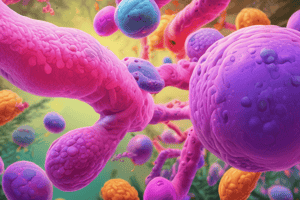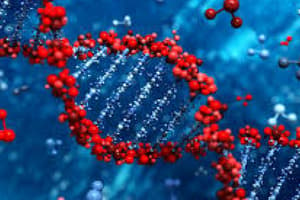Podcast
Questions and Answers
Why is genetic testing for multiple endocrine neoplasia type 1 (MEN1) recommended in young patients with gastrinomas or insulinomas?
Why is genetic testing for multiple endocrine neoplasia type 1 (MEN1) recommended in young patients with gastrinomas or insulinomas?
Young patients are more likely to have hereditary causes of these tumors. Identifying MEN1 helps in managing other potential endocrinopathies and associated pancreatic NETs.
What is the significance of performing multiphasic CT or MRI of the abdomen in the evaluation of pancreatic NETs?
What is the significance of performing multiphasic CT or MRI of the abdomen in the evaluation of pancreatic NETs?
These imaging modalities help in detecting and characterizing the tumor, assessing its size, location, and relationship to surrounding structures, and identifying potential metastases to the liver or other sites.
Explain the rationale behind recommending surgery for functional pancreatic NETs when more than 90% of the tumor can be resected.
Explain the rationale behind recommending surgery for functional pancreatic NETs when more than 90% of the tumor can be resected.
Resecting a significant portion of the tumor reduces hormone hypersecretion and alleviates related symptoms. It potentially provides long-term control and improves the patient's quality of life.
Describe the Verner-Morrison syndrome and its association with VIPoma. What are the key clinical features?
Describe the Verner-Morrison syndrome and its association with VIPoma. What are the key clinical features?
Detail the medical management strategies for gastrinomas, including when to involve a gastroenterologist.
Detail the medical management strategies for gastrinomas, including when to involve a gastroenterologist.
Discuss the differential diagnosis of a patient presenting with the classic symptoms of Zollinger-Ellison syndrome. What other conditions should be considered, and how would you differentiate them?
Discuss the differential diagnosis of a patient presenting with the classic symptoms of Zollinger-Ellison syndrome. What other conditions should be considered, and how would you differentiate them?
Explain why endoscopic ultrasonography (EUS) is the preferred method for staging and tissue diagnosis of ampullary adenocarcinoma.
Explain why endoscopic ultrasonography (EUS) is the preferred method for staging and tissue diagnosis of ampullary adenocarcinoma.
Outline the typical presentation of glucagonoma and explain the underlying mechanisms leading to each symptom.
Outline the typical presentation of glucagonoma and explain the underlying mechanisms leading to each symptom.
Describe the role of octreotide scintigraphy or somatostatin-based PET in detecting small pancreatic NETs. When are these imaging modalities particularly useful?
Describe the role of octreotide scintigraphy or somatostatin-based PET in detecting small pancreatic NETs. When are these imaging modalities particularly useful?
For nonfunctional pancreatic NETs associated with multiple endocrine neoplasia type 1 (MEN1) and von Hippel-Lindau syndrome, why is surgery usually recommended if tumors exceed 2 to 3 cm?
For nonfunctional pancreatic NETs associated with multiple endocrine neoplasia type 1 (MEN1) and von Hippel-Lindau syndrome, why is surgery usually recommended if tumors exceed 2 to 3 cm?
Flashcards
Pancreatic NETs
Pancreatic NETs
Rare tumors, representing 3% of primary pancreatic neoplasms.
Most common functional pancreatic NETs secrete
Most common functional pancreatic NETs secrete
Gastrin (gastrinoma) or insulin (insulinoma).
Primary symptom of Insulinoma
Primary symptom of Insulinoma
Hypoglycemia.
Zollinger-Ellison syndrome
Zollinger-Ellison syndrome
Signup and view all the flashcards
Verner-Morrison syndrome symptoms
Verner-Morrison syndrome symptoms
Signup and view all the flashcards
Glucagonoma classic presentation
Glucagonoma classic presentation
Signup and view all the flashcards
Genetic testing recommended
Genetic testing recommended
Signup and view all the flashcards
Imaging pancreatic NETs
Imaging pancreatic NETs
Signup and view all the flashcards
Medical management of gastrinomas
Medical management of gastrinomas
Signup and view all the flashcards
Usual presentation of Ampullary Adenocarcinoma
Usual presentation of Ampullary Adenocarcinoma
Signup and view all the flashcards
Study Notes
- Pancreatic neuroendocrine tumors (NETs) account for 3% of pancreatic neoplasms.
- Functional pancreatic NETs hypersecrete hormones and represent 10% to 25% of pancreatic NETs, with gastrin or insulin being the most common.
- Nonfunctional NETs are often discovered incidentally.
- The liver is the most common site for metastases of pancreatic NETs.
- Gastrinomas and insulinomas are the most frequent functional pancreatic NETs.
- Other hormones that may be hypersecreted include glucagon, vasoactive intestinal peptide, adrenocorticotropic hormone, somatostatin, serotonin, and parathyroid hormone–related hormone.
- Insulinoma's primary symptom is hypoglycemia.
- Gastrinoma classically presents with Zollinger-Ellison syndrome, including GERD and peptic ulcer disease.
- VIPoma typically presents with Verner-Morrison syndrome: watery diarrhea, hypokalemia, and achlorhydria.
- Glucagonoma classically presents with necrotic migratory erythema, weight loss, hypoalbuminemia, and impaired glucose tolerance.
- Genetic testing for multiple endocrine neoplasia type 1 is recommended in young patients with gastrinomas or insulinomas and in individuals with a family history of endocrinopathies or multiple pancreatic NETs.
- Pancreatic NETs can be sporadic or linked to hereditary tumor syndromes, therefore one should consider genetic testing.
- Multiphasic CT or MRI of the abdomen is recommended for imaging.
- Endoscopic ultrasonography has a 90% sensitivity for detecting small lesions.
- Octreotide scintigraphy or somatostatin-based PET may be needed to detect small lesions.
- Surgery is recommended for functional pancreatic NETs if more than 90% of the tumor can be resected.
- For nonfunctional tumors associated with multiple endocrine neoplasia type 1 and von Hippel-Lindau syndrome, surgery is typically recommended if the tumors exceed 2 to 3 cm.
- Medical management of gastrinomas includes oral proton pump inhibitors two or three times daily or somatostatin analogs.
- High-volume or progressive disease is best managed in conjunction with a gastroenterologist.
Ampullary Adenocarcinoma
- Adenocarcinoma of the ampulla of Vater accounts for 0.2% of gastrointestinal malignancies.
- Ampullary Adenocarcinoma usually presents early because of obstruction of the biliary system.
- Endoscopic ultrasonography with biopsy is the preferred method for staging and tissue diagnosis, with 90% accuracy.
- At least 50% of patients with familial adenomatous polyposis syndrome develop adenomatous changes of the periampullary region, which may progress to adenocarcinoma.
- Hereditary tumor syndromes can cause ampullary adenocarcinomas, hence, patient should be considered for genetic testing.
Studying That Suits You
Use AI to generate personalized quizzes and flashcards to suit your learning preferences.
Description
Pancreatic neuroendocrine tumors (NETs) account for 3% of pancreatic neoplasms. Functional pancreatic NETs hypersecrete hormones, with gastrin or insulin being the most common. Nonfunctional NETs are often discovered incidentally, and the liver is the most common site for metastases.




